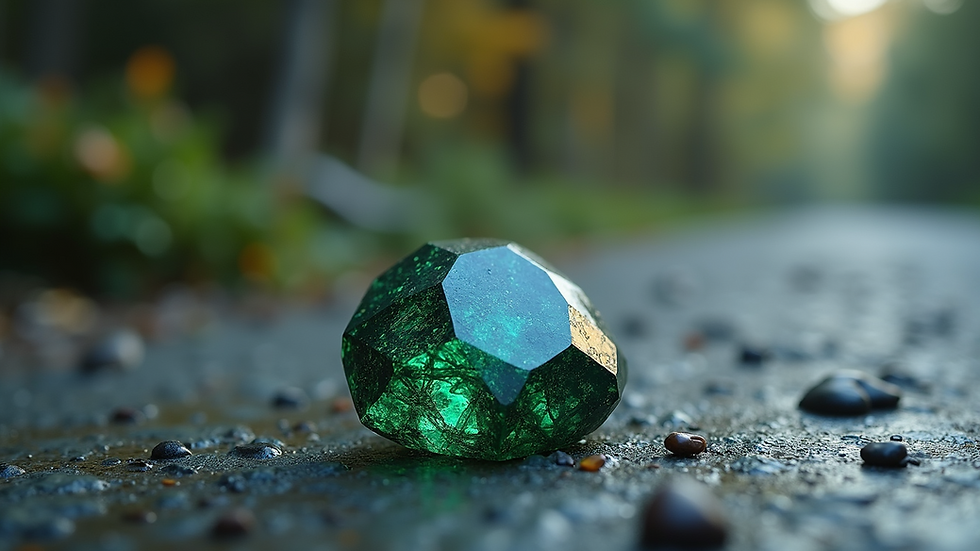Understanding Andalusite Mineral Properties
- Letitia chaplin
- Aug 24
- 4 min read
Andalusite is a fascinating mineral known for its unique crystal structure and remarkable physical properties. This mineral has captured the interest of geologists, gem enthusiasts, and collectors alike. Its distinct characteristics make it a valuable specimen in both scientific study and ornamental use. In this article, we will explore the various aspects of andalusite, focusing on its crystal traits, composition, and practical applications.
Exploring Andalusite Crystal Traits
Andalusite is a silicate mineral that belongs to the orthorhombic crystal system. Its crystals often form prismatic shapes with well-defined edges, which can be easily identified by their elongated and columnar appearance. One of the most striking features of andalusite is its pleochroism - the ability to show different colours when viewed from different angles. This optical property makes andalusite crystals particularly attractive for use in jewellery.
The colours of andalusite crystals range from green to reddish-brown, sometimes exhibiting a mix of hues within a single crystal. This variation is due to the way light interacts with the mineral’s internal structure. The crystal’s hardness is about 6.5 to 7.5 on the Mohs scale, making it durable enough for various uses without being too brittle.
Andalusite’s chemical formula is Al2SiO5, which means it is composed of aluminium, silicon, and oxygen. This composition contributes to its stability under high temperatures and pressures, often found in metamorphic rocks. The mineral’s density typically ranges from 3.1 to 3.2 g/cm³.

Physical and Optical Characteristics of Andalusite
Understanding the physical and optical characteristics of andalusite is essential for identifying and utilising this mineral effectively. Andalusite crystals exhibit a vitreous to resinous lustre, giving them a shiny and glass-like surface. The fracture is usually uneven to conchoidal, and the mineral does not have cleavage planes, which means it breaks irregularly rather than along flat surfaces.
The pleochroism mentioned earlier is one of the most important optical traits. When viewed under polarized light, andalusite can display three distinct colours, typically green, yellow, and reddish-brown. This property is not only visually appealing but also helps gemologists distinguish andalusite from similar minerals.
In addition, andalusite has a relatively high refractive index, ranging from 1.63 to 1.69. This contributes to its brilliance when cut and polished. The mineral is also known for its thermal stability, which means it can withstand high temperatures without altering its structure or colour.
These physical and optical traits make andalusite a versatile mineral for both scientific research and decorative purposes.

What is andalusite used for?
Andalusite has several practical uses, ranging from industrial applications to jewellery making. Due to its high resistance to heat and pressure, andalusite is often used in refractory materials. These materials are essential in industries that require heat-resistant linings, such as furnaces, kilns, and reactors. The mineral’s ability to maintain its integrity under extreme conditions makes it a valuable component in these applications.
In the gemstone market, andalusite is prized for its unique colour-changing properties. It is cut into various shapes and sizes for use in rings, pendants, and earrings. The pleochroic nature of andalusite means that each gemstone can display a range of colours depending on the angle of light, making it a favourite among collectors and designers.
Additionally, andalusite is sometimes used in geological studies as an indicator mineral. Its presence can provide valuable information about the temperature and pressure conditions during the formation of metamorphic rocks.

How to Identify Genuine Andalusite Crystals
Identifying genuine andalusite crystals requires attention to several key features. First, examine the crystal shape. Authentic andalusite typically forms elongated, prismatic crystals with sharp edges. The presence of pleochroism is another strong indicator. By rotating the crystal under a light source, you should observe a change in colour, usually between green, yellow, and reddish-brown.
Testing the hardness can also help confirm authenticity. Andalusite’s hardness of 6.5 to 7.5 means it can scratch glass but can be scratched by harder materials like quartz or topaz. Checking the refractive index with a gemological tool can provide further confirmation.
It is important to be cautious when purchasing andalusite gemstones, as synthetic or treated stones may mimic its appearance. Always buy from reputable dealers and request certification if possible.
Caring for Andalusite Crystals and Gemstones
Proper care is essential to maintain the beauty and durability of andalusite crystals and gemstones. Due to its moderate hardness, andalusite can be scratched by harder materials, so it should be stored separately from other gemstones. Use a soft cloth or padded box for storage.
Cleaning andalusite is best done with warm, soapy water and a soft brush. Avoid harsh chemicals or ultrasonic cleaners, as these can damage the stone’s surface or alter its colour. When wearing andalusite jewellery, remove it before engaging in activities that could cause impact or abrasion.
By following these simple care tips, you can ensure that your andalusite pieces remain vibrant and intact for years to come.
For those interested in learning more about the unique andalusite mineral properties, exploring this mineral further can reveal even more about its geological significance and practical uses. Whether for scientific study or personal collection, andalusite offers a fascinating glimpse into the natural world’s complexity.







Comments